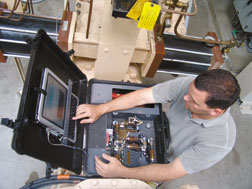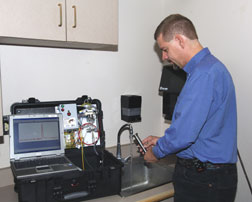NEWS RELEASES
FOR IMMEDIATE RELEASE
September 27, 2005
Two Sandia microChemLab technologies soon to be checking for toxins in the nation’s water supplies
 Sandia researcher Jay West calibrates an instrument
as part of a project to determine the steps necesary to
identify toxins in drinking water.
Sandia researcher Jay West calibrates an instrument
as part of a project to determine the steps necesary to
identify toxins in drinking water.Download 300dpi JPEG image, “watersensor-jay.jpg,” 284K (Media are welcome to download/publish this image with related news stories.)
ALBUQUERQUE, N.M. — Two technologies developed at the National Nuclear Security Administration’s Sandia National Laboratories are expected to soon be checking for toxins and harmful bacteria in the nation’s water supplies. Both are based on the microChemLab.
The microChemLab, officially called microChemLab, is a hand-held “chemistry laboratory.” The liquid prototype was designed and built at Sandia/California, while the microChemLab that takes measurements in the gas phase was developed at Sandia/New Mexico.
Complete with the microChemLab, electronics, and sample collector,
both devices weigh about 25 pounds and fit into a box the
size of a small suitcase. The only external parts of the
two sensor technologies are water collectors. The units
are completely portable.
 Curt Mowrey tests typical Sandia tap water for trihalomethanes.
Curt Mowrey tests typical Sandia tap water for trihalomethanes.Download 300dpi JPEG image, “watersensor-curt.jpg,” 1.3MB (Media are welcome to download/publish this image with related news stories.)
“Our goal is to place these sensors within utility water systems and use them to quickly determine if the water contains harmful bacteria and toxins,” says Wayne Einfeld, who heads the Sensor Development Focus Area within Sandia’s Water Initiative (www.sandia.gov/water). “This on-site monitoring approach would enhance current utility monitoring systems that require water samples to be sent to laboratories for analysis, which sometimes takes days for results.”
The United States has more than 300,000 public supply water wells, 55,000 utilities, 120,000 transient systems at rest stops or campgrounds, and tens of millions of hydrants. Up until now, real-time, remote water quality monitoring for toxins has been very limited.
The liquid microChemLab is currently being tested at the Contra Costa (Calif.) Water District, says Jay West, California principal investigator. Specifically, the team is testing to determine the steps necessary to identify toxins in drinking water, as well as expanding its capabilities as an autonomous monitor. The device is presently collecting and analyzing a water sample every 30 minutes and reporting results via a real-time data link to researchers at Sandia. In the first stages of development, this technology has the potential for early detection of biological toxins and could prove to be very helpful in maintaining the integrity of the nation’s water supplies. Sandia’s cooperative research and development agreement (CRADA) partners in the California endeavor are CH2M Hill, a leading US engineering firm, and Tenix, an Australian engineering services company. CH2M Hill is a global engineering and construction management firm with particular expertise in sewer and wastewater treatment design. Tenix is a company with more than 30 years’ experience in water supply, sewerage, and drainage infrastructure.
The California microChemLab identifies proteins by separating samples into distinct bands in seconds to minutes. Separations occur in channels as narrow as a human hair coiled onto a glass chip about the size of a nickel.
Curtis Mowry, principal investigator for the New Mexico project, says his team is seeking to develop a device that detects trihalomethanes, undesirable byproducts of the chlorination process used to control the bacterial content of water. Trihalomethanes, which can form when surface water is treated with chlorine, are carcinogenic and can have adverse liver and kidney effects.
“The EPA has regulations for water utilities to monitor for trihalomethanes on a regular schedule,” Mowry says. “Currently they have to collect samples and send them to labs for analysis. They get numbers back a few days later. This is a scary thing for us as consumers. The way it’s done now, chemists may have measured high levels and there is chance someone has already consumed the water before the utility has the analysis results. Using the microChemLab will provide a way to bring the labs to the site and get results in a more timely manner.”
The microChemLab system is expected to help water utilities to limit the initial formation of trihalomethanes by functioning as a component of a process control loop.
New Mexico’s portable unit analyzes a sample of water by bubbling air through it and collecting trihalomethanes from that air. The collector is heated, sending the trihalomethanes through a separation column and then over a surface acoustic wave (SAW) detector.
“The collector and the separation column can be purchased off the shelf, but the SAW detector is at the heart of the microChemLab,” Mowry says. “The goal by the end of summer is to replace the commercial separation column with a Sandia microfabricated column made using micro-fabrication technology to reduce the power needed and increase performance.”
Commercial columns are about four to five inches in diameter. Microfabricated columns will be half a square inch. They are in development and need further tuning for trihalomethanes.
The Sandia/New Mexico microChemLab uses similar concepts to the California one — collect, separate, and detect. The main difference is at the “front end” of the device, where different capabilities are needed to be able to extract gases such as trihalomethanes from the water.
“Both systems will speed the analytical process and give the utility operator better information in a shorter time period,” Einfeld says. “In addition to routine water quality monitoring, both are expected to be part of early warning systems that can help alert utility operators to intentional contamination events that might occur at vulnerable locations downstream from treatment plants.”
And finally, he says, “In both of these projects Sandia has successfully leveraged MicroElectricalMechanical Systems (MEMs)-based core technologies nurtured by various DOE programs into the water security applications area.”
Sandia is a multiprogram laboratory operated by Sandia Corporation, a Lockheed Martin company, for the U.S. Department of Energy’s National Nuclear Security Administration. Sandia has major R&D responsibilities in national security, energy and environmental technologies, and economic competitiveness.
Sandia media contact: Chris Burroughs, coburro@sandia.gov, (505) 844-0948
Sandia technical contacts: Wayne Einfeld, weinfel@sandia.gov, (505) 845-8314; Curtis Mowry (New Mexico), cdmowry@sandia.gov, (505) 844-6271; Jay West (California), jawest@sandia.gov, (925) 294-3224